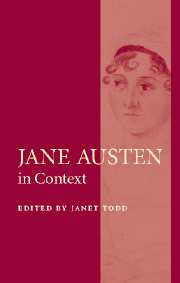2 - Chronology of Composition and Publication
Published online by Cambridge University Press: 19 December 2020
Summary
Despite the slimness of Jane Austen's written fiction production (six completed novels, two fragments of novels, a collection of juvenilia, and a novella-in-letters), it is no easy matter to determine issues of chronology. There are three obvious chronologies: of composition, of redrafting and of publication; and they do not follow unproblematically from each other. For example, until 1870 and the publication of the Memoir by her nephew James Edward Austen-Leigh (JEAL), it was assumed, on the basis of the ‘Advertisement, by the Authoress’ attached to the posthumously published Northanger Abbey, that though her latest work to appear in print this was her first completed novel. Austen had written there: ‘This little work was finished in the year 1803, and intended for immediate publication.’ In pioneering accounts of Austen's fiction, like that by Julia Kavanagh in 1863, a good case is made for Northanger Abbey, with its cross-references to a range of contemporary novels and novel writers, as the sophisticated debut of a new voice. But in the Memoir JEAL included the copy of a letter written by Jane Austen's father on 1 November 1797 to Thomas Cadell, a noted London publisher, offering the manuscript of a novel in three volumes, ‘about the length of Miss Burney's “Evelina”.’ He conjectures (he has no hard evidence) that this ‘must have been’ the novel which eventually became Pride and Prejudice. Cadell declined to publish sight unseen, but the possibility of a completed version of Pride and Prejudice before Austen was twenty-two gives her novel-writing career a different trajectory. Things become more complicated when we realise that Pride and Prejudice in its 1797 version was probably further removed from the novel finally published under that title in 1813 than Northanger Abbey in 1803 from the version eventually published posthumously in 1818. Three of Austen's six novels (Sense and Sensibility, Pride and Prejudice and Northanger Abbey ) led such confusing double lives.
Of enduring significance for how critics have viewed Austen’s creative life has been JEAL's more misleading suggestion that the six novels were the products of two distinct and matching creative periods – roughly Austen's early twenties and her late thirties – and that these two periods were divided by a largely fallow interlude of around eight years.
- Type
- Chapter
- Information
- Jane Austen in Context , pp. 12 - 22Publisher: Cambridge University PressPrint publication year: 2005
- 7
- Cited by



